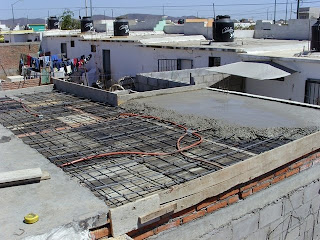






.jpg)
"Release the line"


 A cool ride for the bride.
A cool ride for the bride. Traditional "Banda" playing Sinaloan style music.
Traditional "Banda" playing Sinaloan style music.



 Making and repairing fishing nets (chinchurros) is what Paco has done since he was 8 years old. He has worked side by side the other old fellow in the photo (sorry, don't remember his name) for over 40 of those years.
Making and repairing fishing nets (chinchurros) is what Paco has done since he was 8 years old. He has worked side by side the other old fellow in the photo (sorry, don't remember his name) for over 40 of those years. You'll see these rocking chairs all over Mazatlan. They're made of welded steel rod and then covered with a web of synthetic cord or small diameter rope. The rope wears out long before the frame does... if it ever does. It took this guy about a half hour to re-string this chair. And it will be good for another few years. He stays busy and supports his wife and five kids by making the rounds all over Mazatlan bringing new life to old rockers.
You'll see these rocking chairs all over Mazatlan. They're made of welded steel rod and then covered with a web of synthetic cord or small diameter rope. The rope wears out long before the frame does... if it ever does. It took this guy about a half hour to re-string this chair. And it will be good for another few years. He stays busy and supports his wife and five kids by making the rounds all over Mazatlan bringing new life to old rockers.
Bill did not arrive a Ua Pou, he was heard making trying to reach a few boats by VHF radio later that afternoon, but apparently wasn't able to receive the answering hails. He sounded calm, and didn't issue a mayday.
The next morning, a guitar, a laptop, and some wreckage were found floating near Nuku Hiva by a local fisherman. A private search found Bill's boat, the Emily Pearl sunk just off the SW coast of Nuku Hiva. The dinghy which doubles as a life-boat (certified life-boat, nearly unsinkable) was not aboard, but no one can be sure at this point if it was launched or if it broke free.When I visited the site today, the boat was within 50 feet of shore.
A safety harness was found in the water on the rocks near shore. To my knowledge Bill always wears his safety harness underway.
The shoreline around the wreck was searched by boat and by plane today but there was no sign of Bill or of the dinghy. Tomorrow divers will inspect the boat to try and determine what happened. A land search will begin tomorrow, in case Bill got ashore and is attempting to hike back to a road, this side of the island is largely uninhabited and pretty steep. A private fisherman will be setting off for a nearby uninhabited island where the dinghy may have drifted to.
I've asked that the divers searching the boat search especially for Bill's hand held VHF radio as
I'm sure he would try to take it with him if he had to abandon the boat.
A waterproof bag containing US currency and US army pins in a cigar box was also recovered today. I'm 99% positive they were Bill's.
It looks like one of the lifelines (plastic coated wire that serves as railing around the deck) broken. If that happened before the boat was sunk it could indicate falling overboard.
All of the divers that have been on the boat say that he is not still in the boat.
If Bill is on land, the local authorities are confident he would not have been able to reach a road by this time. Bill is very competent to survive on the terrain, water and fruit are available, and the climate is warm.


 Paco and his brother Ricardo are installin the "magera" (plastic hose) for electric wiring for lights, all of which will be securely buried in the concrete roof. Supported by a gridwork of metal rebar.
Paco and his brother Ricardo are installin the "magera" (plastic hose) for electric wiring for lights, all of which will be securely buried in the concrete roof. Supported by a gridwork of metal rebar. The roof is partially filled with cement.
The roof is partially filled with cement.
 My Mexican friends laugh when they see them. It must be extremely funny to see a gringo wearing huaraches.
My Mexican friends laugh when they see them. It must be extremely funny to see a gringo wearing huaraches.


